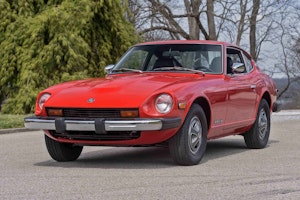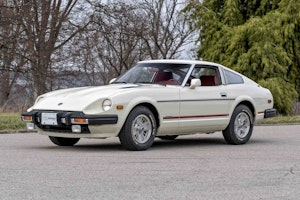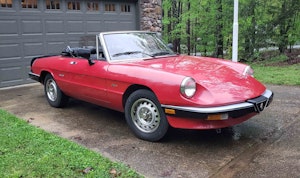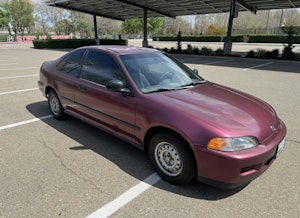Media | Articles
The Nissan Altima Invigorated the Family Sedan, Then Ruined It
Perhaps you remember the quality of Japanese cars during the Bubble Era, but there’s a good chance you’ve forgotten the semi-premium positioning of Nissan’s Stanza Altima from 1993. Brands going upmarket was par for the course in the early 1990s, and Nissan saw gold in an Oldsmobile-like vehicle that bridged the gap between their value-oriented offerings and Infiniti’s premium positioning. They were right, and it spawned an iconic vehicle for the best and worst reasons you can bestow upon a family sedan.
Let’s discuss the good vibes first: with Infiniti J30-like styling, a remarkably luxurious interior with faux-rosewood accents, and a $13,000 base price, the original Altima was promoted as an affordable luxury sedan. The nameplate became an instant hit. David Woodhouse, vice president of Nissan Design America, even suggested the Altima was “a Goldilocks of its time: just enough, not too much; a sweet car, with sensibility just right for a mainstream sedan.”
Woodhouse nailed it, and inadvertantly gave a quote that applies to many Bubble Era Japanese cars. But the country changed when the economy soured, and the second-generation Altima was cheaper and boring, with a drab interior and a deformed trunk. Luckily, Nissan had a new platform up their sleeves specifically for the American market, one that sported proper American dimensions and aggressive proportioning.

That chassis turned into the third-generation Nissan Altima for 2002. No longer looking like a cost-engineered Infiniti J30, the new Altima was aimed squarely at the ubiquitous Camry and Accord. It was longer, wider, and taller than anything in its class, setting the new standard years before the Chrysler 300 became a boxy Bentley on a budget. The Altima’s fresh look featured a gentle rise in its belt line, 17-inch wheels pushed out to the corners, and the radical implementation of the Lexus IS-style (i.e. Toyota Altezza) tail lights: Heady stuff for a family sedan.
The huge interior lacked the original’s multi-toned polymers and elongated plasti-wood strips for the dashboard, though its clever gauge cluster had the intimacy of a motorcycle’s triple gauge pod. Just like the original Stanza-Altima, this model put the competition on notice and racked up awards in the process.
Marketplace
Buy and sell classics with confidence


“The concept behind the third-generation Altima styling and engineering was simple—stop copying Accord and Camry, as we had been doing—and carve out fresh territory of our own.”
Al Castignetti, Nissan Sales and Marketing VP
Nissan did their job, right down to making a high performance “SE” version with a 3.5-liter V-6 engine (from Nissan’s VQ family), four wheel disc brakes, and a multi-link rear suspension. Perhaps the third (and fourth?) generation Altimas were so good that the only place it could go from there was downhill.

And downhill it went. Just as Altimas had hit their stride, along came a guy named Carlos Ghosn: While his current situation is far from black and white, name drop this former CEO to anyone associated with U.S.-based Nissan dealerships and gauge their reaction. My decade in automotive retail made it clear that Nissan was a pariah, mostly thanks to Ghosn’s inhumane stair step plan after the 2008 recession. The plan was to increase Nissan/Infiniti market share to 10 percent by 2017, which instead tanked the brand’s equity with consumers and dealers alike. This was most notably manifested in the Altima. But you already knew that, didn’t ya?

Package Nissan’s bargain basement discounting, diminished resale value, and worrisome X-Tronic CVT transmissions with the fact that sedans were beginning to cede territory to CUVs, and you doom the fifth- and sixth-generation Altima to automotive leprosy.
But for a brief moment—before Big Altima Energy (BAE) was a thing—the third-generation Altima was a radically compelling vehicle for so many folks.
You could rightly suggest that Motorweek’s take on this new family sedan proved there was BAE afoot. But that used to be a good thing: Camry-killing style with performance-minded swagger, in a full trickle-down effect from the 4DSC Maxima from Nissan’s Bubble Era. Even the four-cylinder Altima’s 175 horsepower was peppy enough to spring to 60 in less than nine seconds. But Motorweek got their hands on a 3.5 SE model, with Nissan’s now commonplace VQ-series V-6 putting out 240 horses and netting a 5.9 second 0-60 time.

Even in today’s era of radically fast EVs and turbocharged family sedans, a sub-six second time to 60 mph is nothing to sneeze at. Some credit goes to the Altima 3.5 SE’s available five-speed manual transmission, though Motorweek noted that torque steer was also present during testing. Their instrumented testing netted a quarter mile trap speed of 100 mph, a figure unheard of in family sedan circles. Heck, a triple digit trap speed shall spank a manual transmission Mustang GT of the era, much less a V-6 Camry or Accord.
This Motorweek retro review took me back to my final year in college. I imagined graduating from my heavily modified Fox-body Cougar and going into $25,000-ish of debt for one of these row-your-own V-6 Q-ships finished in “Seascape” metallic green. Aside from the desire to do front-wheel drive burn outs just like Motorweek did on TV, my post-grad plan was to have a reliable new car, a good job, and a pathway to grow up into a proper adult. And since it’s an Altima, I could enjoy a respectable family sedan for what should be a future with a wife, kids, and a good career with upward mobility.


But that wasn’t in the cards, as I smacked the same brick wall many millennials faced upon their respective graduations just a few years later. Be it as a dreamer or an owner, I doubt I’m the only person who waxes nostalgically about these Altimas, especially the 3.5 SE. It was an affordable sedan that seemingly did it all, a halfway point between the appeal of an SUV and the thrills of a touring car.
No vehicle is perfect, but this one came awfully close. Even the current Altima, with jokes readily available on the Internet and present at the airport rental lots around the country, is a respectable vehicle by the numbers alone. I’ve driven several and have no qualms, as the BAE memes are a badge of honor, not a scarlet letter.

Perhaps that’s because of the legacy created when Nissan gave the world the 2002 Altima 3.5 SE. It’s a shame what happened to the nameplate after that moment, as stair-stepping CEOs and public perceptions tanked the Altima’s prospects for victory. Tragedies are unavoidable without the benefit of hindsight, but least the Altima remains in production while many of its ballyhooed sedan competition passed on years ago.
***
Check out the Hagerty Media homepage so you don’t miss a single story, or better yet, bookmark it. To get our best stories delivered right to your inbox, subscribe to our newsletters.





















I’m a bubble (golden) era Honda guy, but I know nothing about Nissans. I didn’t understand most of the references in this article. What’s the stair step plan? I read the link, but it didn’t explain it either. I have no idea what BAE is – I clicked that link too, but I don’t have Facebook and just got a sign in page with no info. What’s a Q-ship? Trying to understand this article turned into a homework assignment. I do at least remember the 4DSC stickers in the rear quarter windows of the 90s Maxima. The references in this article read like an inside joke and I’m not in the click. Please keep the diversity of your audience in mind when writing these (or read one of Murilee Martin’s always outstanding articles for how to properly incorporate vast troves of information / links)
Sorry about the lack of clarity, I will try to explain here:
1. Stair Step Plan: an incentive program Nissan gave to dealers that made incentives (to them, not to the customer) on a stair step, not a smoother line/curve. Getting to that next step was pretty hard sometimes, if I remember correctly. And the things you did to get up to the next step were bad for the brand’s reputation with the general public.
2. Sorry but BAE is best represented on Facebook: Big Altima Energy. Maybe this link is better: https://www.reddit.com/r/regularcarreviews/comments/1195c6r/what_makes_something_big_altima_energy/
3. Q-ship is a British term for a sleeper car, something with a lot of power but doesn’t look like it has performance.
With the problem of CVT of the past, they are no longer an affordable family car. They load them up with upgrades to make more money. Now they are out of the range of the market buyers that made them famous.
The Altima wasn’t Nissan (Datsun)’s first Q ship. The 1968 Datsun 510 was a mechanical clone of the BMW 1600-2 for about 600 fewer dollars. OHC 4 cylinder, 85 or so hp, nice 4 speed, disc brakes in front, IRS in the rear. Even within a few inches in dimensions of the BMW. Very successfully raced in SCCA sedan racing, and in the small bore Trans Am races. Datsun dropped that same engine (looking suspiciously like a contemporary Mercedes 190) into its 520 pickup truck and boosted the truck’s hp by 25.
No experience with modern Nissan cars, but have owned a string of Nissan trucks, the newest which has a 4 liter version of the Sentra’s V6–makes that heavy 4×4 Frontier step along right smartly with a 6 speed manual! Perking right along at 100k miles too.